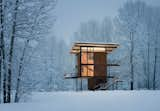A polychrome facade made of salvaged, 100-year-old barnwood gives this small, lofted cottage space its unique character. Its copper roof is also reclaimed, a lucky Craigslist find from a local remodel. Though the structure has a footprint of just 11' x 14', it provides a useful space to entertain, catch up on work, or relax.
The site needed a path that would let residents easily ascend from the bank to the house. The architects created one by simply replicating the way they had naturally walked up the site the first time they visited. The result is a meandering trail that directs visitors to the landscape’s different features — whether a majestic Arbutus tree, a private stone beach, or a wildflower clearing.
“They wanted the new cabin to make a ‘L’ shape with the older cabin, but I convinced them to mimic the old cabin on the opposite side,” architect D’Arcy Jones says. “So the new site has two buildings across from each other, like an equal sign.” Birch trees grow between the cabins in a shared courtyard.






